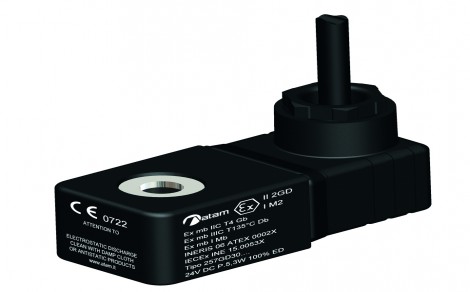- Home » Editorial » Pneumatics
The unknown ATEX world

ATEX environments, with their potentially explosive atmospheres, are far more widespread than many may realise. In addition to the obvious environments of oil and mines, many other situations warrant an ATEX approach due to the presence of gas and dust which can combine to create a volatile atmosphere capable of reacting to ignition sources such as hot surfaces, electrical material, electrostatic charges and mechanical sparks.
An estimated 70% of industrial settings have to deal with these problems. Think of the agrifood, textile, metalworking, woodworking industries and any setting where gas under pressure is used, and this list is far from exhaustive. ATAM has studied in depth its clients’ operating fields with potentially explosive atmospheres to understand where its coils and valves would be used. This has allowed the company to acquire the expertise to provide an all-round consulting service to ensure coil-solenoid valve units with unparalleled performance and safety.
An in-depth knowledge of the ATEX world has enabled ATAM to provide various families of products – certified by internationally recognised external bodies – for the most widespread pneumatic and hydraulic applications, covering a variety of risk categories.
Coils for pneumatics
The 257 encapsulated coil is for heavy-duty pneumatic applications. It’s certified ATEX 2014/34/EU and IECEx for gas (Zone 1) and dust (Zone 21) and has been approved even for mine applications (Group I, Category M2).
This encapsulated coil features a UL-approved housing developed to further protect internal components and includes a precision thermal fuse placed in direct contact with the external surface of the encapsulation. All encapsulation materials have undergone extensive flame tests to meet the requirements of all three Glow Wire Tests. Domestic applications are covered by ISO EN 60335-1 requirements. The 204, 394, and 209 coils are for Zone 2 and Zone 22 applications (normal protection level). These coils were created as standard products and their safety was later enhanced to meet ATEX requirements as non-sparking coils. They are equipped with a wireless DIN connection and are ideal for applications up to Category 3 GD according to Directive ATEX 2014/34/EU.
Coils for hydraulics
The 455 coil is for heavy-duty hydraulic applications. These coils feature an Ex-d explosion-proof casing certified ATEX and IECEx for gas (Zone 1), dust (Zone 21) and mines (Category M2). The technical features of the 455 solenoid valve make it completely safe in these potentially explosive atmospheres. The 455 coil stands out for its micro-cast coated low carbon steel body and flanges, which undergo a zinc and nickel treatment to improve their resistance to oxidation. This coil is supplied without wire and cable gland. Based on the client’s requirements, it can be powered with a voltage ranging from 6 to 240 V, both AC and DC. Moreover, it can work with an operating pressure equal to 350 dynamic bar and a room temperature ranging from -60degC to +80degC with T4, T5 and T6 temperature classes.
-
PPMA 2025
23 September, 2025, 9:30 - 25 September, 2025, 16:00
NEC, Birmingham UK -
Advanced Engineering Show 2025
29 October, 2025, 9:00 - 30 October, 2025, 16:00
NEC, Birmingham UK










